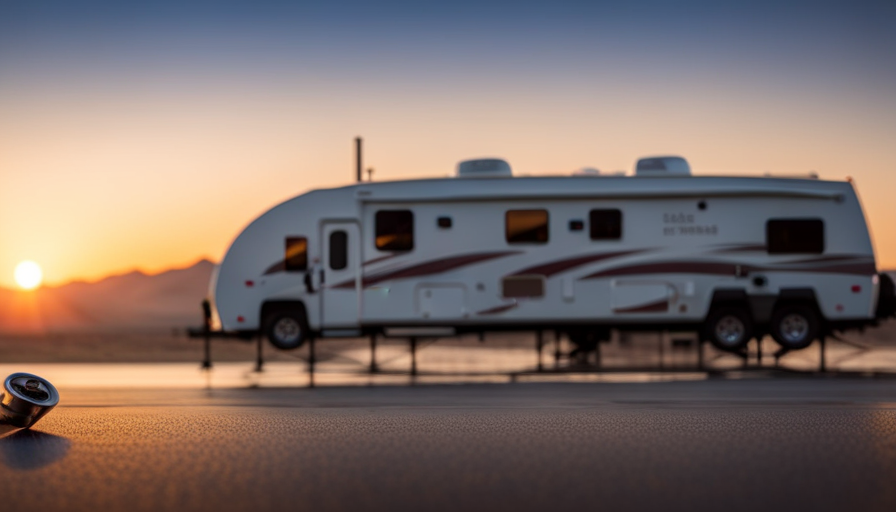Imagine yourself driving down the highway, towing your camper, when suddenly, a strong gust of wind hits the side of your vehicle. Immediately, your camper starts to sway, causing your heart to race and forcing you to grip the steering wheel tighter. This is a stressful situation that every camper owner wants to prevent.
But fear not, fellow adventurers, for there is a solution to this hair-raising dilemma: sway bars. These seemingly small and unassuming devices serve a crucial role in ensuring a smooth and stable towing experience. By harnessing the power of physics, sway bars work tirelessly to combat the forces that cause your camper to sway, providing you with peace of mind and control on the open road.
In this article, we will delve into the world of sway bars, exploring their function, different types, installation process, and safety tips. So buckle up, dear readers, and prepare to embark on a journey that will equip you with the knowledge to enjoy a worry-free camping excursion.
Key Takeaways
- Sway bars prevent swaying of campers while towing by connecting the camper’s axle to its frame and equalizing weight distribution.
- They minimize lateral movement or sway caused by wind and uneven roads, improving towing stability.
- Sway bars can be traditional, using friction or cams, or integrated into weight distribution hitches or electronic sway control systems.
- Proper installation and maintenance of sway bars are crucial for a safe and worry-free camping experience.
What is a Sway Bar?
If you want to keep your camper stable and secure while driving, you need to make sure you have a sway bar installed—it’s an absolute game-changer! Understanding the mechanics of sway is crucial to grasping the importance of proper sway bar installation.
Sway, also known as lateral movement, occurs when your camper swerves or rocks from side to side. This can happen when you encounter strong winds, uneven road surfaces, or when making sharp turns. Sway bars, also called anti-sway bars or stabilizer bars, are designed to minimize this lateral movement and keep your camper steady on the road.
The sway bar connects the axle of your camper to its frame. When sway occurs, the bar transfers the force from the side experiencing less pressure to the side experiencing more pressure, effectively equalizing the weight distribution. This counteracts the swaying motion and helps maintain stability. Without a properly installed sway bar, your camper is at a higher risk of swaying excessively, which can lead to loss of control and potential accidents.
Understanding the physics of sway is essential for safe towing. By comprehending how sway occurs and the role of a sway bar in managing it, you can take the necessary precautions to ensure a smooth and secure journey. [Transition into the subsequent section about ‘understanding the physics of sway’]
Understanding the Physics of Sway
When it comes to towing a camper, understanding the physics of sway is crucial. Side-to-side movement can have a significant impact on the towing experience, making it difficult to maintain control and stability on the road.
However, sway bars are designed to minimize sway by connecting the tow vehicle to the camper, providing added resistance and reducing the side-to-side movement.
Side-to-Side Movement and Its Impact on Towing
By reducing side-to-side movement, sway bars on a camper enhance towing stability, ensuring a smoother and safer journey for adventurers on the road.
Side-to-side movement, commonly known as sway, can occur while towing a camper due to various factors such as crosswinds, uneven road surfaces, and sudden lane changes. This movement can be unsettling and dangerous as it affects the overall stability of the vehicle and trailer.
Weight distribution plays a crucial role in reducing sway. When the weight is evenly distributed between the camper and the towing vehicle, it minimizes the chances of sway occurring.
Sway bars, also known as stabilizer bars or anti-sway bars, are designed to further mitigate this side-to-side movement. They connect the camper’s frame to the towing vehicle’s suspension system, reducing the transfer of forces between them and limiting the sway. This ensures a safer and more controlled towing experience.
Transitioning into the subsequent section, let’s explore how sway bars minimize sway.
How Sway Bars Minimize Sway
Sway bars are essential for a smoother and more enjoyable towing experience by reducing side-to-side movement. One key factor in minimizing sway is weight distribution. When the weight of the camper is evenly distributed, the trailer is less likely to sway.
Sway bars work by connecting the camper’s frame to the tow vehicle’s frame, creating a stable connection. This connection allows the tow vehicle to counteract any side-to-side movement, keeping the camper in line.
Additionally, road conditions play a significant role in sway control. Uneven surfaces, potholes, and strong winds can all contribute to sway. Sway bars help to minimize these effects by providing additional stability and control.
Now, let’s delve into the different types of sway bars and their specific features.
Different Types of Sway Bars
There are three main types of sway bars that are commonly used in campers: traditional sway bars, weight distribution hitch with integrated sway control, and electronic sway control systems.
Traditional sway bars are the most basic type and work by using torsion to resist the swaying motion of the camper.
Weight distribution hitches with integrated sway control are designed to not only distribute the weight of the trailer evenly, but also to provide additional sway control.
Electronic sway control systems use sensors to detect any swaying motion and automatically apply the brakes to individual wheels in order to counteract the sway.
Traditional Sway Bars
If you’re driving a camper, you’ll be amazed to know that traditional sway bars can reduce trailer sway by up to 90%. These sway bars come in different types, each with their own benefits.
The most common type is the friction sway bar, which uses friction to counteract the movement of the trailer. It is attached to the frame of the camper and the hitch, providing stability and control.
Another type is the dual-cam sway control, which uses cams to distribute the forces evenly and effectively reduce sway.
These traditional sway bars are designed to keep your camper steady and prevent dangerous swaying motions. However, if you’re looking for even more advanced sway control, you might consider a weight distribution hitch with integrated sway control.
This next section will explore this option in more detail.
Weight Distribution Hitch with Integrated Sway Control
Get ready to experience a whole new level of control and peace of mind with a weight distribution hitch that seamlessly integrates sway control.
When it comes to weight distribution hitch installation, choosing the right sway control system is crucial. With an integrated sway control feature, this hitch ensures that weight is evenly distributed across the trailer and tow vehicle, minimizing sway and enhancing stability during travel.
The system works by using spring bars to transfer weight from the rear axle of the tow vehicle to the front axle, improving steering and braking control. In addition, the integrated sway control mechanism detects any movement or sway and applies the necessary force to counteract it, keeping the trailer in line with the tow vehicle.
This combination of weight distribution and sway control provides a safer and more comfortable towing experience.
Moving on to the next section about electronic sway control systems, these offer another level of sophistication in controlling trailer sway.
Electronic Sway Control Systems
Now let’s dive into the world of Electronic Sway Control Systems, which take the concept of sway control to a whole new level.
These systems utilize advanced electronic technology to detect and counteract trailer sway in real-time. By constantly monitoring the movement of the camper and the tow vehicle, electronic sway control systems can quickly apply the brakes on individual wheels or adjust the trailer’s braking system to prevent or minimize sway.
The benefits of using electronic sway control are numerous. Firstly, these systems provide an additional layer of safety by actively intervening to prevent trailer sway before it becomes dangerous. Secondly, they offer a more precise and responsive sway control compared to traditional mechanical sway bars. Lastly, electronic sway control systems can be adjusted and fine-tuned to suit different towing scenarios and trailer weights, providing a customized and optimized towing experience.
Transitioning to the next section, let’s now explore the benefits of using sway bars for camper towing.
Benefits of Using Sway Bars
When it comes to towing a camper, using sway bars can provide several benefits. One of the key advantages is improved stability and control. Sway bars help to minimize the side-to-side movement of the trailer, allowing for smoother and more controlled towing.
Additionally, sway bars enhance safety on the road by reducing the risk of trailer sway, which can lead to accidents or loss of control.
Overall, using sway bars is a wise choice for anyone looking to enhance the towing experience and ensure a safer journey.
Improved Stability and Control
By improving stability and control, sway bars on a camper provide a smoother and safer towing experience. The main purpose of sway bars is to reduce trailer sway, which can occur when towing a camper. When a camper sways from side to side, it can lead to a loss of control and a dangerous situation on the road.
Sway bars work by connecting the camper’s frame to the tow vehicle’s suspension system, effectively distributing the weight and forces evenly. This helps to minimize any side-to-side motion and keeps the camper in line with the tow vehicle. As a result, the improved towing performance allows for a more comfortable and controlled ride.
With enhanced stability and control, the risk of accidents and mishaps is significantly reduced, ensuring a safer journey on the road. Transitioning into the next section about enhanced safety on the road, sway bars play a crucial role in preventing accidents and maintaining control of the camper.
Enhanced Safety on the Road
To ensure your journey on the road is as safe as possible, it’s essential to understand the importance of enhanced safety measures.
One of the key benefits of sway bars on a camper is the reduction of trailer sway. When towing a camper, it is common for the trailer to sway from side to side due to various factors such as wind gusts or uneven road surfaces. This can be dangerous and greatly affect your control over the vehicle.
Sway bars help to minimize this sway by distributing the weight evenly between the camper and the towing vehicle. This improved weight distribution provides better stability and control, reducing the risk of accidents and ensuring a smoother ride.
Understanding the importance of weight distribution and installing sway bars properly is crucial for a safe and enjoyable camping trip.
Transitioning into the subsequent section about how to properly install sway bars, it is important to follow these steps to ensure the best performance and safety.
How to Properly Install Sway Bars
Installing sway bars on a camper is like giving it a shot of espresso, turning it from a sleepy sloth into a caffeinated cheetah. Proper installation is crucial for enhanced safety on the road. To ensure a successful installation, it’s important to follow a few key steps.
First and foremost, proper maintenance of the camper’s suspension system is essential. Before installing sway bars, it’s important to inspect the existing suspension components for any signs of damage or wear. This includes checking the bushings, bolts, and brackets for any signs of corrosion or looseness. Addressing any maintenance issues beforehand will ensure the sway bars can be installed on a solid foundation.
One common installation mistake is improper torqueing of the bolts. It’s essential to use a torque wrench and tighten the bolts to the manufacturer’s specifications. This’ll ensure that the sway bars are securely attached to the camper’s chassis, providing optimal stability and control.
Another important step is to properly position the sway bars. They should be installed symmetrically, with the same amount of distance between the sway bar and the camper’s frame on both sides. This’ll ensure that the weight distribution is balanced, allowing for effective sway control.
Installing sway bars on a camper requires proper maintenance and attention to installation details. By following these guidelines, you can ensure a safe and stable towing experience. Now, let’s delve into maintaining and troubleshooting sway bars, which’ll further enhance the performance and longevity of your camper’s suspension system.
Maintaining and Troubleshooting Sway Bars
Maintaining and troubleshooting sway bars can ensure a smooth and stable towing experience, keeping your camper’s suspension system in peak condition. Here are some key points to consider:
-
Regular inspection: Check the sway bar for any signs of wear, such as cracks or bends. Also, inspect the bushings and brackets for any damage. Replace any worn or damaged parts immediately to prevent further issues.
-
Lubrication: Apply lubricant to the sway bar bushings to reduce friction and ensure smooth movement. This will help prolong the lifespan of the sway bar and prevent it from squeaking or binding.
-
Proper adjustment: Ensure that the sway bar is properly adjusted to the correct tension. If it’s too loose, it may not effectively control sway, and if it’s too tight, it can affect the ride quality. Follow the manufacturer’s recommendations for proper adjustment.
-
Troubleshooting tips: If you experience excessive sway or uneven towing, check for any loose or missing bolts, as well as any signs of damage or wear. Also, ensure that your camper’s weight distribution is properly balanced.
Maintaining and troubleshooting sway bars is crucial to ensure the safety and stability of your camper while towing. In the next section, we’ll discuss important factors to consider when using sway bars.
Factors to Consider When Using Sway Bars
When using sway bars, you’ll want to consider the various factors that can affect the stability and control of your towing experience, ensuring a smooth and secure journey. Understanding sway dynamics is crucial in this regard.
Sway bars, also known as anti-sway bars or stabilizer bars, are essential components of a camper’s suspension system. They are designed to reduce the side-to-side movement, or sway, that can occur when towing a camper.
One important factor to consider is the proper weight distribution. Uneven weight distribution can have a significant impact on sway control. To achieve optimal stability, it is vital to distribute the weight evenly between the camper and the tow vehicle. This can be achieved by using a weight distribution hitch, which redistributes the weight from the rear axle of the tow vehicle to the front axle, providing better balance and control.
Another factor to consider is the compatibility of the sway bars with your particular camper and tow vehicle. Different campers have different weights and towing characteristics, so it’s important to choose sway bars that are specifically designed for your setup. Additionally, regular maintenance and inspection of the sway bars are crucial to ensure their effectiveness.
Understanding these factors and taking the necessary precautions will greatly enhance the stability and control of your towing experience. In the next section, we will discuss some important sway bar safety tips to further ensure a safe and enjoyable journey.
Sway Bar Safety Tips
When it comes to using sway bars on a camper, there are several factors to consider for ensuring a safe and stable towing experience. In the previous subtopic, we discussed the important factors to consider when using sway bars. Now, let’s delve into some essential safety tips to keep in mind.
Sway bar maintenance is crucial to ensure optimal performance and prevent common sway bar problems. Here are some safety tips to follow:
-
Regular inspection: Check the sway bar for any signs of wear, such as cracks or excessive rust. Also, inspect the mounting brackets and bushings for damage or looseness.
-
Lubrication: Apply lubricant to the sway bar bushings to reduce friction and allow for smooth operation.
-
Proper installation: Ensure that the sway bar is correctly installed and tightened to the manufacturer’s specifications. This will help maintain its effectiveness and prevent unnecessary vibrations.
-
Weight distribution: Properly distribute the weight of your camper to prevent excessive sway. Make sure the load is evenly distributed and secured within the trailer.
By following these safety tips and maintaining your sway bar, you can minimize the risk of sway-related accidents and enjoy a more stable towing experience.
Now, let’s explore the alternatives to sway bars and how they can enhance your camper’s stability.
Sway Bar Alternatives
When it comes to alternatives to sway bars, there are three main options to consider: stabilizer jacks, airbags, and suspension upgrades.
Stabilizer jacks are designed to provide additional stability and support to the camper, reducing the risk of swaying.
Airbags, on the other hand, are installed in the suspension system to help level the camper and improve stability.
Lastly, suspension upgrades involve enhancing the existing suspension system of the camper to improve its overall performance and reduce sway.
Stabilizer Jacks
Stabilizer jacks help to enhance the stability of a camper by reducing the sway and movement caused by external factors. These jacks are an essential component of the camper’s leveling system, as they provide additional support and prevent the camper from rocking or tipping over.
Stabilizer jacks are typically positioned at the corners of the camper, and they can be extended or retracted to adjust the height and levelness of the camper. This ensures that the weight of the camper is evenly distributed, minimizing the risk of instability. Stabilizer jacks are designed to withstand heavy loads and provide a firm foundation, making them an effective solution for reducing sway.
However, it’s important to note that stabilizer jacks alone may not completely eliminate sway. To further enhance the stability of the camper, airbags and suspension upgrades can be considered. These components work in conjunction with the stabilizer jacks to provide a more secure and controlled ride.
Airbags and Suspension Upgrades
To enhance the stability of your camper to the extreme, consider upgrading your suspension system with airbags. This will make your ride feel as smooth as gliding on a cloud. Air suspension benefits are numerous and can greatly improve your towing experience.
First, airbags provide adjustable support, allowing you to level your camper even on uneven terrain. This ensures that weight is distributed evenly, preventing swaying and improving control.
Second, air suspension reduces the impact of bumps and vibrations, enhancing ride comfort and protecting your camper from unnecessary wear and tear.
Lastly, airbags can be easily installed, either by replacing the existing suspension components or by adding supplemental air springs. The installation process is straightforward and can usually be done with basic tools.
With air suspension upgrades, you can enjoy a smoother and more stable towing experience.
Conclusion: Enjoy a Smooth and Stable Towing Experience with Sway Bars
Experience a smooth and stable towing adventure like never before with the help of sway bars! Sway bars, also known as anti-sway bars or stabilizer bars, play a crucial role in improving towing performance and preventing trailer swaying.
When towing a camper, trailer swaying can be a major concern, causing discomfort, instability, and even accidents. However, with the addition of sway bars, these issues can be significantly reduced, providing a safer and more enjoyable towing experience.
Sway bars work by connecting the suspension of the tow vehicle to the suspension of the camper. This connection helps distribute the weight evenly between the two, minimizing any potential imbalance that could lead to swaying. By effectively reducing the side-to-side movement of the trailer, sway bars enhance stability and control, allowing for smoother turns and maneuvering.
Installing sway bars on your camper is a wise investment, especially if you frequently tow heavy loads or travel on windy roads. They’re relatively easy to install and can make a world of difference in terms of towing comfort and safety.
Whether you’re a seasoned camper or just starting out, sway bars are an essential accessory that shouldn’t be overlooked. So, equip your camper with sway bars and enjoy a smooth and stable towing experience like never before!
Frequently Asked Questions
How often should sway bars be replaced?
When to replace sway bars depends on the signs of wear and tear. Typically, sway bars have a lifespan of 5-10 years, but this can vary depending on usage and conditions. Regular maintenance is crucial to prolong their lifespan. Signs of wear and tear include cracks, rust, or looseness. If you notice any of these signs, it’s recommended to replace the sway bars to ensure optimal performance and safety while towing a camper.
Can sway bars be installed on any type of camper?
Yes, sway bars can be installed on any type of camper. Installing sway bars provides numerous benefits, such as improved stability and control while towing the camper. Sway bars help to minimize side-to-side movement and reduce the risk of trailer sway, especially during windy conditions or when passing large vehicles.
The installation process involves attaching the sway bars to the camper’s frame and hitch, ensuring a secure and effective setup.
Are sway bars necessary for small trailers or pop-up campers?
Sway bars aren’t necessary for small trailers or pop-up campers because they’re lighter and have a lower center of gravity. However, they’re useful for larger RVs or motorhomes. Sway bars reduce side-to-side movement and sway caused by wind or passing vehicles, providing a more stable towing experience. To properly install and adjust sway bars, make sure they’re securely attached to both the trailer frame and tow vehicle. Adjust the tension to optimize performance and minimize sway.
Can sway bars prevent all types of swaying or just certain ones?
Sway bars are an essential tool for preventing all types of swaying on campers, not just certain ones. They work wonders in different weather conditions, providing stability and control.
Whether it’s heavy winds or uneven road surfaces, sway bars ensure a smooth and safe towing experience. Installing sway bars is a relatively straightforward process, but it’s crucial to follow the manufacturer’s instructions for proper installation.
Remember to regularly inspect and maintain your sway bars for optimal performance.
Do sway bars affect the overall weight capacity of a camper?
Sway bars don’t directly affect the overall weight capacity of a camper. Their primary function is to reduce the swaying or lateral movement of the camper while being towed. However, it’s important to properly adjust the sway bars according to the towing capacity of the camper. This ensures optimal performance and stability during towing.
To adjust sway bars for camper towing, consult the manufacturer’s guidelines and consider factors such as the weight distribution and load of the camper.
Can Sway Bars Affect the Width of a Camper Door?
The camper door width is not directly affected by sway bars as they are designed to minimize the side-to-side movement of a vehicle while driving. However, excessive swaying can potentially put additional stress on the camper’s structure, potentially affecting the door if it’s not properly reinforced or if it opens towards the side. Proper installation and maintenance of both the sway bar and the camper are important for overall safety and stability.
Conclusion
After investigating the truth behind the theory, we can confidently conclude that sway bars are a crucial component for a smooth and stable towing experience with a camper.
By understanding the physics of sway, different types of sway bars, and the proper installation process, campers can benefit greatly from using sway bars.
It’s important to consider factors such as weight distribution and safety tips when using sway bars.
Additionally, there are alternative options available for those who may not prefer sway bars.
Overall, by utilizing sway bars correctly, campers can enjoy a safe and enjoyable towing experience.










